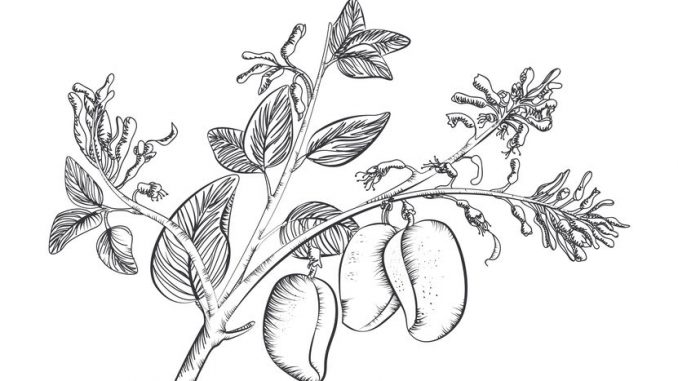
The tropical shrub Griffonia simplicifolia Baill. (fam. Caesalpinaceae) which grows in West Africa (Ghana, Ivory Coast and Togo in particular), has a remarkable pedigree in African folk medicine (Irvine, 1961). The leaves are commonly used to treat wounds and the leaf juice for kidney and bladder ailments. The seeds are also harvested, dried and sold as an aphrodisiac as well as being an antimicrobial and action against diarrhea, stomach ache and being an anti-emetic. Unfortunately, the scientific evidence for its use is weak.
Griffonia Extracts And Precursors To Serotonin
The Griffonia seed extract has a high 5-HTP (5-hydroxy-l-tryptophan) content – about 6 to 14%. The presence of such high concentrations makes it toxic presumably to certain larvae which would normally feed on it such as Prodenia eridania and Callosobruchus maculates (Bell, 1976; Bell et al., 1976). The compound 5-HTP is present in low levels in the CNS (central nervous system) where it is manufactured in vivo from L-tryptophan before being converted to serotonin (5-HT), by catalysis using an amino acid decarboxylase enzyme (AADC) (Sloley and Juorio, 1995). Serotonin is a key neurotransmitter in mammalian systems, playing a major role in memory and mood. Its absence is noted in many disorders such as schizophrenia (Filip and Bader, 2009) and high anxiety (Kahn and Westerberg, 1985). The seed extract could also be used to manage migraine and headache according to various web-sites basing evidence on reports by Sommer (2006) and Panconesi (2008). This was tested in children at the Center for Childhood Headache in the Second University of Naples where the Griffonia extract was compared with administration of ginkgolide B (Esposito et al., 2012). The authors though are reserved on the findings, preferring to focus on ginkgolide as the preparation of choice and there was no comparison with a placebo.
Administering Griffonia seed extract might serve as a natural alternative to medication because serotonin supplementation has been shown in animal models to have a positive benefit in those suffering personality, sex or sexual behaviour disorders (Carnevale et al., 2010) or anxiety disorders (Arai et al., 1995; Kitahama et al., 2002). Recently, a rat model has been tested to understand the potency of the anxiolytic affect of administering a Griffonia seed extract using various tests (dark-light test, open field test) (Carnevale et al., 2011).
The measurement of serotonin in Griffonia seed samples was recently the subject of a strong analytical study using a gold modified pencil graphite electrode (GPGE) coupled to differential pulse voltametry (DPV) and amperometry. (Kalachar et al., 2011). The search for a natural form of treatment for migraine and other mental disorders continues and the general perception is that it is only at the beginning of that road.
Brands Using Griffonia.
Look out for brands which offer Griffonia or purified forms of 5-HTP. One very well established brand is Solgar which has been around since 1947.
References
Arai, R., Karasawa, N., Nagatsu, T., Nagatsu, I. (1995) Exogenous l-5- hydroxytryptophan is decarboxylated in neurons of the substantia nigra par compacta and locus coeruleus of the rat. Brain Res. 669, pp. 145–149.
Bell, E.A. (1976) FEBS Letts. 64 pp. 29
_______., Fellow, L.E., Quareshi, M.Y. (1976) Phytochemistry 15 pp. 823
Carnevale, G., Di Viesti, V., Zavatti, M., Benelli, A., Zanoli, P. ( 2010) Griffonia simplicifolia negatively affects sexual behavior in female rats. Phytomed., 17(2) pp. 987-991
Carnevale, G., Di Viesti, V., Zavatti, M. Zanoli, P. (2011) Anxiolytic-like effect of Griffonia simplicifolia Baill. seed extract in rats. Phytomed., 18 pp. 848-851 (Article)
Esposito, M., Ruberto, M., Pascotto, A., Carotenuto, M. (2012) Nutraceutical preparations in childhood migraine prophylaxis: effects on headache outcomes including disability and behaviour. Neurol Sci. 33(6): pp. 1365–1368.
Filip, M., Bader, M. (2009) Overview on 5-HT receptors and their role in physiology and pathology of the central nervous system. Pharmacol. Rep. 61, pp. 761–777.
Irvine, F.R. (1961) Woody Plants of Ghana. Oxford University Press, p. 308.
Kahn, R.S., Westenberg, H.G., (1985) l-5-Hydroxytryptophan in the treatment of anxiety disorders. J. Affect. Disord. 8, pp. 197–200.
Kalachar, H. C. B., Arthoba Naik, Y., Basavanna, S., Viswanatha, R., Venkatesha, T.G. (2011) Amperometric and differential pulse voltammetric determination of 5-Hydroxy-L-tryptophan in pharmaceutical samples using gold modified pencil graphite electrode. J. Chem. Pharm. Res., 3(3) pp. 530-539
Kitahama, K., Jouvet, A., Fujimiya, M., Nagatsu, I., Arai, R. (2002) 5-Hydroxytryptophan (5-HTP) uptake and decarboxylation in the kitten brain. J. Neur. Transm. 109, pp. 683–689.
Panconesi A (2008) Serotonin and migraine: a reconsideration of the central theory. J. Headache Pain 9 pp. 267–276
Sloley, B.D., Juorio, A.V. (1995) Monoamine neurotransmitters in invertebrates and vertebrates: an examination of the diverse enzymatic pathways utilized to synthesize and inactivate biogenic amines. Int. Rev. Neur. 38, pp. 253–303.
Sommer, C. (2006) Is serotonin hyperalgesic or analgesic? Curr Pain Headache Rep. 10(2) pp. 101–106

Leave a Reply